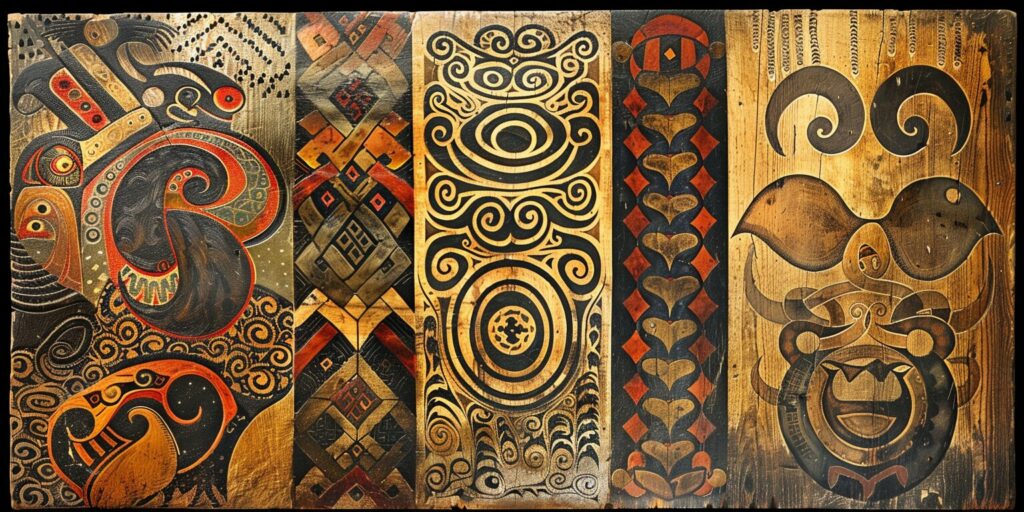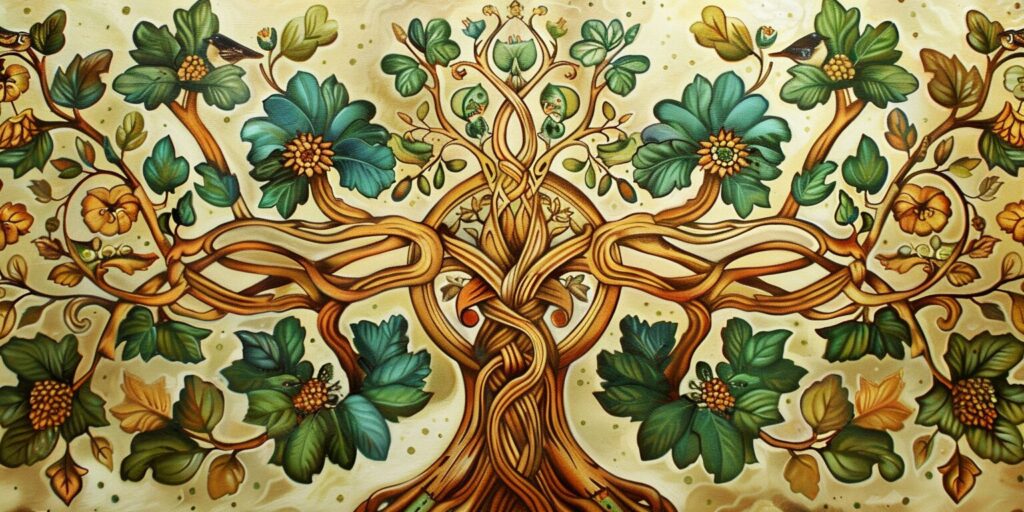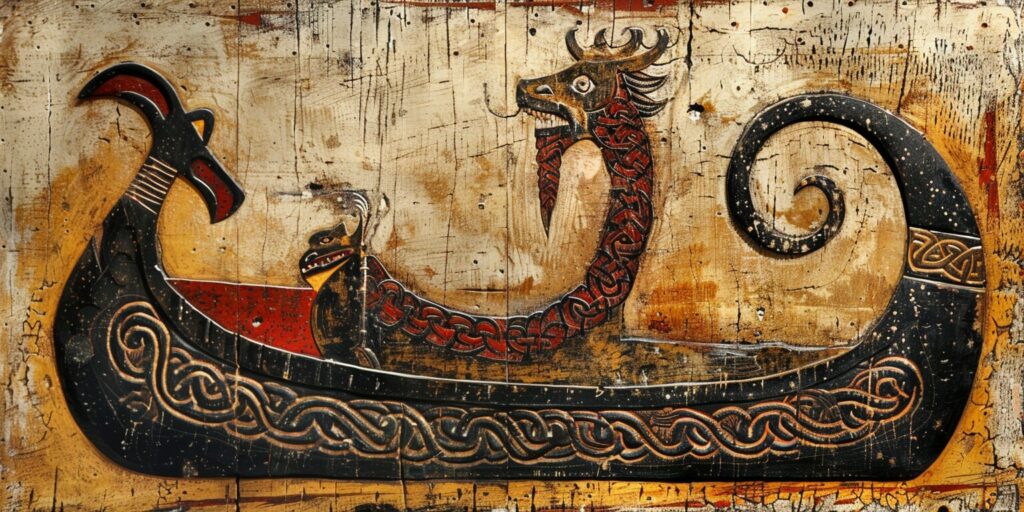Daily Life in the Viking Age, Viking Heritage, Vikings
Traditional Viking Patterns: Unveiling the Intricacies of Viking Art
Viking patterns are more than pretty designs. They tell us about Norse myths and what they value. These patterns come from the late 8th to mid-11th century.
They were used on metal, fabric, wood, and stone. Famous examples are the Oseberg ship burial and the Urnes Stave Church. These show us the detailed and beautiful side of Viking art.
A lot of work has gone into studying these patterns. Places like the National Museum of Denmark help us learn more. Their research teaches us about Viking art and their culture.
What are Traditional Viking Patterns?
Traditional Viking patterns are like a time machine, showing us the Vikings’ lives and beliefs. These patterns are full of deep meanings, showing what the Vikings cared about. We’ll talk more about what they mean, how they changed, and what they usually look like in the context of Viking Age art.
The Significance of Viking Patterns in Art
Viking patterns are more than just art. They tell us what the Vikings thought and valued. Through their art, the Vikings shared their myths and how they saw the world. Their designs weren’t just for looks but were thought to protect and bring luck.
This style of art often used lines that weave together, spirals, and animals. These designs decorated everyday things with importance. So, each object carried deep cultural and spiritual meanings, echoing themes from Viking Age art.
Exploring the Evolution of Viking Patterns
Viking patterns started with simple designs but grew more complex over time. At first, they used mainly straight lines and basic shapes, typical of early Viking Age art. Then, they added twisty, interlacing patterns and animal figures.
This change shows how their art evolved as their society did. It also shows how they were influenced by other cultures. So, each new pattern marked a step forward in their artistic and cultural journey.
Common Elements in Traditional Viking Patterns
In traditional Norse Viking art, you’ll often see axes, boats, animals, and knots. These elements were used on many things, like stones with writings, things for horses, and axe heads from ancient sites. Each symbol and animal had its own special meaning.
For example, axes stood for power and protection, motifs frequently found in Viking Age art. Pictures of dragons or snakes meant guarding against evil. These symbols show how Viking art was deeply linked to their lives and beliefs, as depicted in numerous runestones.
How did Vikings Incorporate Patterns into their Art?
The Vikings were skilled at integrating detailed patterns into their art, which showed their strong link to Norse culture and stories. The designs were more than decoration; they had deep symbols and meanings.
Viking Age Motifs and Symbolism
Their art often used creatures like the gripping beast and Norse gods. These symbols represented power, safety, and courage. The patterns were like a story, sharing the Norse people’s beliefs and values.
The Influence of Norse Culture on Viking Patterns
Norse culture greatly influenced the patterns in Viking artworks. Artisans used stories and runes in their work, often seen in runestones. This made their art a deep part of Norse culture, showing their design and skill.
Patterns Found in Oseberg and Jellinge Viking Art Styles

The Oseberg style, from the Oseberg ship burial, is known for its detailed designs. These carvings often show complex scenes and patterns. On the other hand, the Jelling style is bold with strong patterns. It’s found on stones and metal. Both styles show how Viking art changed from intricate to bold.
What are the Key Features of Viking Patterns?
Viking patterns are famous for their detailed designs, reminiscent of the Gotland and Jelling styles. They include images of axes, ships, spirals, tendrils, and animals. These weren’t just decorations; they carried strong messages and beliefs from Viking times.
Distinctive Viking Age Motifs: Axes and Ships
Axes and ships stand out in Viking art. Axes show strength and courage. Ships represent their skillful sea travels. You can find these symbols in weapons, jewelry, and even on ancient stones and original Viking carvings.
Exploring the Intricate Spiral and Tendril Patterns
Spirals and tendrils are common in Viking work. They come from nature and mean life and forever. These patterns show up in metal, wood, and fabric. They talk about how everything is linked and continues, much like the interconnected motifs in Viking pattern images.
Symbolism Behind Beast Motifs in Viking Art
Like the gripping beast, beasts are key in historical real Viking art. They show a love for nature and a touch of Christian faith. Images of beasts mix myth with real power and protection. They also connect the Vikings to something greater.
How to Identify Different Viking Pattern Styles?
Understanding Viking pattern styles means knowing their special looks. Each one comes from a different time and place in Viking history. These styles show the Vikings’ unique art and culture.
Deciphering Ringerike, Borre, and Urnes Style Patterns
The Ringerike style showcases detailed plant designs from the late 1000s. At the same time, the Borre style shows spiraling knots found in the Borre mound. The Urnes style is all about elegant, twisting animals like those in Norway’s Urnes Stave Church.

Unique Characteristics of Jellinge and Mammen Style Patterns
The Jellinge pattern stands out with its animal appearance and special eyes. The Mammen axe, with its leafy patterns, marks a mix of fighting and art. Both of these bring out Viking skills in art and battling.
Exploring the Artistic Patterns of Oseberg and Gripsholm Style
The Oseberg patterns come from treasures in an Oseberg ship grave. They draw detailed stories of myths and wild beasts. The Gripsholm patterns add a twist to common Viking art, mixing beauty with a deep meaning.
Where Can Viking Patterns be Found Today?
Viking patterns are still very popular. They are used in today’s fashion, home decor, and graphic design. Many designers use these patterns as a base for their work, finding inspiration in Viking images.
Modern Applications of Viking Patterns in Design
Modern Viking design is a blend of old and new. It’s common to see Viking designs in architecture and interior design. These patterns add a unique historical flair to floors or wallpapers inspired by Viking pattern images. They breathe life into both homes and businesses.
Utilizing Viking Patterns in Contemporary Art and Textiles
Today’s Norse art scene is vibrant. Artists use Viking designs as a jump-off. They create work filled with intricate patterns, often influenced by runestones. This fusion of older designs with new ideas pops up in textiles, too, reflecting patterns and ideas from the Viking Age. You’ll find Viking patterns on everything from rugs to clothes. Festivals and games also keep traditional Norse Viking art alive, showing its lasting impact.
Conclusion
Exploring Viking patterns shows how deeply old art and our love for Scandinavian roots are connected through 10th-century designs. These detailed designs are more than just pretty; they show the Viking Age’s impact and celebrate Norse creativity and skill. Viking patterns aren’t just for looks; they carry a rich tradition, encouraging new art of the Viking Age and making design more vibrant.
Viking designs like spirals and animal motifs bridged the time when artwork was part of daily life. These Norse patterns keep their artistic traditions alive by telling us stories and showing how well functionality and beauty blended in that era. Studying and using these traditional designs today makes the Viking spirit live on, keeping their culture important over the years.
Viking motifs are being rediscovered, and they fit right in with today’s art and design. From clothes to jewelry to graphics, these patterns appeal to everyone who loves the Nordic tradition. This lasting interest ensures Viking art stays influential, captivating people who enjoy art and those who love history.

